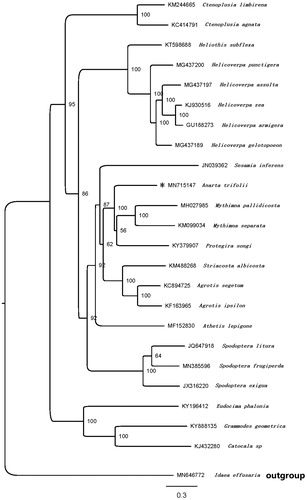Abstract
The Anarta trifolii belongs to Noctuidae in Lepidoptera. The complete mitogenome of A. trifolii was described in this study, which is typical circular duplex molecules and 15,281 bp in length, containing the standard metazoan set of 13 protein-coding genes, 22 transfer RNA genes, 2 ribosomal RNA genes, and an A + T-rich region. The gene order is same with other lepidopterans. Except for cox1 started with CGA, all other PCGs started with the standard ATN codons. Most of the PCGs terminated with the stop codon TAA, whereas nad3 is TAG, nad4 has the incomplete stop codon T. The phylogenetic tree showed that A. trifolii and other three species belong to Hadeninae, which are clustered into a clade.
Anarta trifolii Hufnagel [1766] is widely distributed in drier, open habitats throughout much of the northern hemisphere, and is often a major agricultural pest. The species is a generalist, feeding on many kinds of herbaceous vegetation, which include peas, lettuce, and cabbage. It belongs to Noctuidae of Lepidoptera. We sequenced the complete mitogenome of A. trifolii in this study, which would facilitate the researches of the phylogeography and phylogenic relationship of Lepidoptera.
In this study, the samples were collected by light trapping in Taiyuan City of China (37°83′33′′N, 112°66′61′′E) in July 2019, some of these specimens were immediately frozen at −80 °C for mitogenome analysis, and others were preserved by spreading wings in the Herbarium of Institute of Plant Protection, Shanxi Academy of Agricultural Sciences, and their numbers are 2019TYKD1722–1727. Total genomic DNA was extracted from tail tip using the Ezup pillar genomic DNA extraction kit (Sangon Biotech, Shanghai, China). The mitogenome was sequenced by Illumina Hiseq 4000. Gene annotation was performed and circularity was checked using the MITOS2 webserver (Bernt et al. Citation2013; http://mitos.bioinf.uni-leipzig.de/).
The mitochondrial genome of A. trifolii has a total length of 15,281 bp (GenBank accesion No. MN715147), consisting of 13 protein-coding genes (PCGs), 22 tRNA, 2 rRNA genes, and an A + T-rich region. The major strand encodes a larger number of genes (9 PCGs and 14 tRNAs) than the minor strand (4 PCGs, 8 tRNAs, and 2 rRNA genes). Gene content and arrangement are highly conserved and typical of Lepidoptera (Wu, Zhao, Su, He, et al. Citation2016, Wu, Zhao, SU, Luo, et al. Citation2016). The mitogenome is highly biased toward A/T, contains 41.33% T, 40.23% A, 10.72% C, and 7.73% G, which is a feature commonly present in insects (Boore Citation1999).
All PCGs have ATN as the start codon except for cox1, which starts with CGA. Eleven PCGs have the common stop codon TAA. However, nad3 have the stop codon TAG, and nad4 has the incomplete stop codon T. All tRNAs exhibit typical clover-leaf secondary structure, except for tRNA-Ser(AGN) lacking the DHU arm, which is common in Lepidoptera insects (Garey and Wolstenholme Citation1989). The 16S rRNA is 1259 bp in length, and the 12S rRNA is 735 bp in length. The A + T-rich region is 278 bp long located between 12S rRNA and tRNA-Met. There is a motif ATAGA in downstream of 12S rRNA followed by an 19 bp Poly-T stretch.
The phylogenetic position of A. trifolii was inferred using sequences of the 13 PCGs of 24 species. Twenty-three of them belong to Noctuidae, and Idaea effusaria from Geometridae (which is used as outgroup) (). The sequences were aligned with MAFFT v7.2 software (Katoh and Standley Citation2013), the evolutionary analyses were conducted with RAxML v8.2.10 (Stamatakis Citation2014) on the CIPRES Science Gateway (Miller et al. Citation2010). The result showed that A. trifolii and other three species Mythimna pallidicosta, Protegira songi, Mythimna separata belong to Hadeninae, which are clustered into a clade. Other species of the same tribes form a monophyly.
Nucleotide sequence accession number
The complete mitochondrial genome sequence of A. trifolii was deposited in GenBank under the accession number MN715147.
Disclosure statement
No potential conflict of interest was reported by the author(s).
Additional information
Funding
References
- Bernt M, Donath A, Juhling F, Externbrink F, Florentz C, Fritzsch G, Putz J, Middendorf M, Stadler PF. 2013. MITOS: improved de novo metazoan mitochondrial genome annotation. Mol Phylogenet Evol. 69(2):313–319.
- Boore JL. 1999. Survey and summary: animal mitochondrial genomes. Nucleic Acids Res. 27(8):1767–1780.
- Garey JR, Wolstenholme DR. 1989. Platyhelminth mitochondrial DNA: evidence for early evolutionary origin of a tRNA ser AGN that contains a dihydrouridine arm replacement loop, and of serine-specifying AGA and AGG codons. J Mol Evol. 28(5):374–387.
- Katoh K, Standley DM. 2013. MAFFT multiple sequence alignment software version 7: improvements in performance and usability. Mol Biol Evol. 30(4):772–780.
- Miller MA, Pfeiffer W, Schwartz T. 2010. Creating the CIPRES science gateway for inference of large phylogenetic trees. In Proceedings of the gateway computing environments workshop (GCE). New Orleans (LA): Institute of Electrical and Electronics Engineers (IEEE); p. 1–8.
- Stamatakis A. 2014. RAxML version 8: a tool for phylogenetic analysis and post-analysis of large phylogenies. Bioinformatics. 30(9):1312–1313.
- Wu YP, Zhao JL, Su TJ, He QS, Xie JL, Zhu CD. 2016. The complete mitochondrial genome of Carposina sasakii (Lepidoptera: Carposinidae). Mitochondrial DNA. 27(2):1432–1434.
- Wu YP, Zhao JL, Su TJ, Luo AR, Zhu CD. 2016. The complete mitochondrial genome of Choristoneura longicellana (Lepidoptera: Tortricidae) and phylogenetic analysis of Lepidoptera. Gene. 591(1):161–176.

